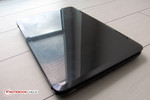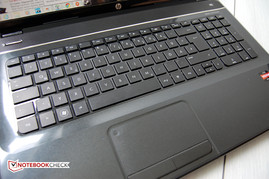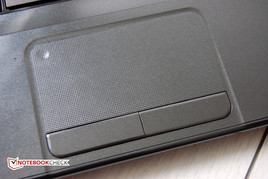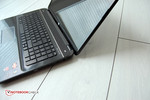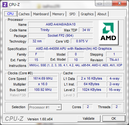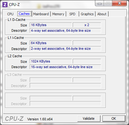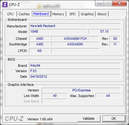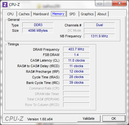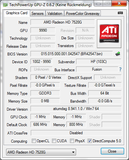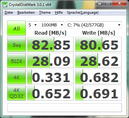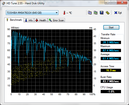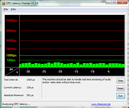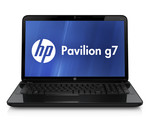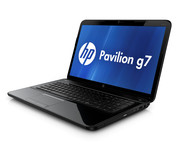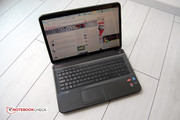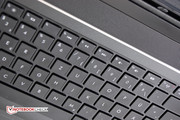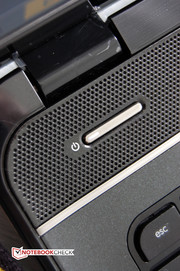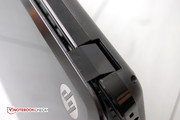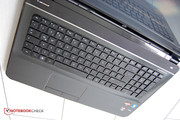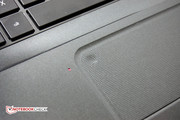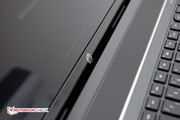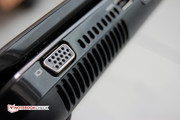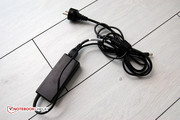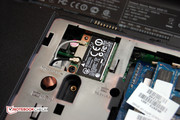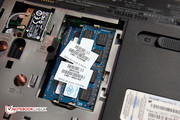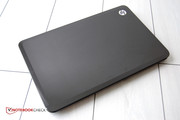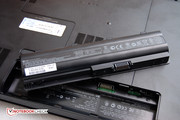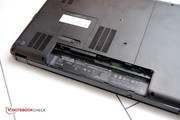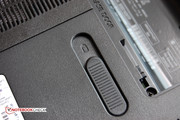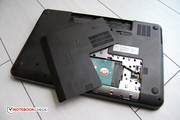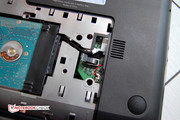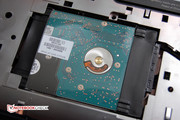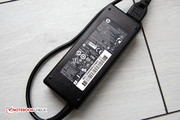Review Update HP Pavilion g7-2053sg Notebook
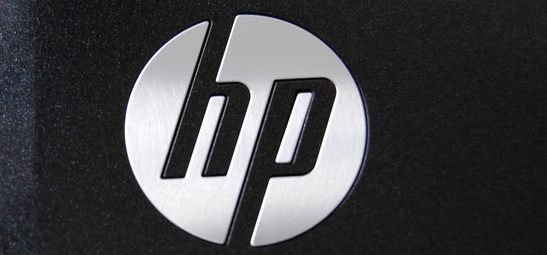
HP's Pavilion series is clearly targeted at home users. The g7-models thereby serve as inexpensive desktop replacement notebooks. Only a few weeks ago, we tested the EUR 599 (~$750) Pavilion g7-2051sg with AMD's A10-4600M. The result was only an average mark. We had to criticize the weak display and the poor assembly quality. In addition, there were an unexceptional battery life and and an annoying fan. On the plus side, the device could score with its well-thought-out configuration and sufficient performance. Also good were the speaker and the rather thin case, weighing just under three kilograms. A special feature of the g7-2051sg was its dual graphics solution based on AMD's crossfire technology. Here, two graphics cards are connected to work together. Naturally, the aim is to improve 3D performance. In our review, however, this promise could not be fulfilled by the Pavilion.
With the HP Pavilion g7-2053sg, another 2000-series model faces up to our tests. On the outward appearance, the g7-2053sg is indistinguishable from the g7-2051sg. Both come with a 17.3-inch-display and sit in an identical plastic case. The differences are only revealed by close observation of the data sheet. Main differences are the CPU and GPU configuration as well as the price. For EUR 499 (~$620) instead of EUR 599 you get an AMD multicore CPU type A10-4600M with the integrated graphics adapter AMD Radeon HD 7520G, both rated as rather entry level. For a EUR 100 (~$125) surcharge, the g7-2051sg offered slightly advanced hardware. In the course of this review, we will deal with further differences.
Case
The case of HP's Pavilion g7-2053sg is identical to the g7-2051sg which was already reviewed. Therefore, all the positive and negative verdicts of the past review apply to this review as well. Thus, we still find fault with the admittedly optically appealing chassis which unfortunately consists almost entirely of very reflective plastic. However, the current model turns out to be of a slightly higher quality than the g7-2051 review model. The fit and finish is a bit steadier, and the scratching noise from the optical drive region is notably less prominent; perhaps a typical case of model variation. Positive aspects like the rounded edges, the moderate weight and the pleasantly slim case are things the Pavilion g7-2053 has in common with its brother.
Connectivity
When it comes to ports and connectors, the recently reviewed HP Pavilion g7-2051sg and the g7-2053sg now in the spotlight are as alike as two peas in a pod. The number, type and position of the sockets is exactly identical. Again, we miss a Gigabit Ethernet port which could replace the in-built Fast Ethernet port. Apart from that, the configuration is consistent and rather comprehensive for a EUR 500 notebook.
Communication
"The same procedure as last year, Miss Sophie?" As for the two HP Pavilion g7 of the 2000 series, the answer is: "the same procedure as every year, James." The g7-2053sg too has a slow Fast Ethernet port and a well-working 802.11n/g/n-WLAN module. The absence of Bluetooth is also carries some weight.
Accessories, Maintenance, Warranty
With regard to all these points, the things mentioned in the review article on the HP Pavilion g7-2051sg hold – without any limitations. Hence, we make no words about them at this point.
Input Devices
Keyboard and Touchpad
Once more, the HP Pavilion g7-2053sg cannot deny its close relatedness to the g7-2041sg which already went through our reviewing procedure. To get to the point, there are no differences. The keys are sufficiently large, have a good key drop, and do not reflect. The touchpad also solves its task satisfactorily. We liked the feature to deactivate the trackpad by tapping twice on a depression in its upper left corner. Again, the mouse keys of our current review model feel a bit spongy.
With our current review device's sister model, the HP Pavilion g7-2051sg, the display was one of our main points of criticism. We found fault with the low brightness, weak contrast and the mediocre viewing angle stability. At the end of the day, our criticism of the built-in TN panel persists without reservations. HP fits the identical display type produced by AU Optronics into the Pavilion g7-205. Thus, the measured results only deviate within measurement and manufacturing tolerance from those of the g7-2051sg. The g7-2053sg too is only conditionally suited for outdoor use.
| |||||||||||||||||||||||||
Brightness Distribution: 95 %
Center on Battery: 181 cd/m²
Contrast: 163:1 (Black: 1.11 cd/m²)
57% AdobeRGB 1998 (Argyll 3D)
81.7% sRGB (Argyll 3D)
55.1% Display P3 (Argyll 3D)
Performance
With regard to performance, buyers of the HP Pavilion g7-2053sg have to lower their sights compared to the g7-2051. Then again, in return they save EUR 100. HP decided to outfit the g7-2053sg with an entry level AMD Trinity APU. The A6-4400M has two cores clocked at 2.7 to 3.2 GHz. The CPU is supported by an integrated graphics card type AMD Radeon HD 7520G which is to be classified as lower middle class. From our point of view, the processor is well-chosen for an entry level model. The 35 watts TDP rating also fits the application area of a plain desktop replacement notebook.
Processor
With devices below EUR 500 like the HP Pavilion g7-2053sg, probably no one expects a real high-end processor. However, even in this price segment performance is asked for, especially if a notebook is to permanently replace the domestic PC. HP decided to go for an APU by AMD which is a combination of CPU and integrated graphics. This is basically a good choice. Although Trinity APUs cannot compete with comparable Intel Ivy Bridge models, AMD fits in a comparatively powerful graphics card.
Still, one must not disregard that the in-built AMD A6-4400m is an entry level model. It has two cores with a base clock frequency of 2.7Ghz. The AMD Turbo Core 3.0 technology enables dynamical overclocking to up to 3.2Ghz, depending on load and temperature.
System Performance
The overall system performance depends on a wide range of factors. Influence variables are the CPU and graphics configuration, graphics card performance, and the memory interface and size. The drivers used can also have a positive or negative impact. Thus, PCMark test results have to be seen as what they are: an individual evaluation of a particular overall system.
In comparison to its "big" brother, the HP Pavilion g7-2051sg, the g7-2053sg performs about 20 percent worse in the PCMark 7 and PCMark Vantage. This is not surprising considering the slower CPU with only half the cores and the omission of a dedicated graphics card. With its overall score, the review model settles roughly on the level of notebooks like the Acer Aspire 5560G or the Lenovo B570-M58G4GE and thus in good company. A more capable hard drive would have possibly lead to a sightly better rating.
| PCMark Vantage Result | 4427 points | |
| PCMark 7 Score | 1533 points | |
Help | ||
Mass Storage
Another difference between the HP Pavilion g7-2053sg and the g7-2051sg can be seen in the choice of the hard drive. By contrast to the slightly more expensive g7-2051sg with a 500 GB Hitachi drive, our current review model comes with a device providing 640 GB disk space. This time, the hard drive comes from Toshiba and spins at 5400 rounds as its predecessor. In the past review, the Hitachi HDD did not cover itself with glory.
And the hard drive inside the HP Pavilion g7-2053sg is not doing much better. Solely in sequential writing, with over 80 MB/s according to CrystalMark, the Toshiba drive reaches a distinctly better result than the sister model. Also fair enough is the access time of 16.9 milliseconds. The bottom line is that the hard drive has to be classified as rather unhurried.
Graphics Card
By contrast to the Pavilion g7-2051sg out of the same notebook family, where a dual graphics solution is employed, in the "smaller" g7-2053sg HP settles for the integrated graphics of the Trinity APU. In concrete terms, it is the AMD Radeon HD 7520G, which should be about on the level of a DirectX-11-capable middle class card. Due to the lack of dedicated memory, it will not perform just as well as a discrete graphics card with similar reference values.
For the application area of HP's Pavilion g7-2053sg the card - or rather the AMD A6-4400M APU is a good choice. The machine is neither declared as a gaming notebook nor developed for very demanding tasks in general. Processor and graphics configuration constitute a good compromise: at least at low settings, many, especially old games run adequately. The overall performance is always sufficient for everyday applications - especially when the good value pricing is considered.
| 3DMark 06 Standard Score | 4332 points | |
| 3DMark Vantage P Result | 2045 points | |
| 3DMark 11 Performance | 560 points | |
Help | ||
Gaming Performance
What was said about the already tested sister model is also true for the HP Pavilion g7-2053sg: It is not a gaming notebook - even less than the g7-2051sg which is simply due to the weaker graphics card. Moreover, HP does without an additional discrete card.
We could not test most games with middle or high settings on the HP Pavilion g7-2053sg because the notebook does not support the resolutions we expect for this purpose. When it comes to the native resolution of 1600x900, we get a rather unambiguous picture: Modern games such as Anno 2070, The Elder Scrolls V: Skyrim or F1 2011 are only playable with low graphics settings, if at all playable. In native resolution and high details nothing but slow flip book animations is possible. Anno 2070 for instance only runs with a meager nine frames per second.
| low | med. | high | ultra | |
|---|---|---|---|---|
| Call of Duty: Black Ops (2010) | 35 | 23 | ||
| F1 2011 (2011) | 22 | 16 | ||
| CoD: Modern Warfare 3 (2011) | 64 | |||
| The Elder Scrolls V: Skyrim (2011) | 25 | |||
| Anno 2070 (2011) | 44 | |||
| Risen 2: Dark Waters (2012) | 15 |
Emissions
System Noise
Concerning the noise characteristics, there have not been a lot of changes from the recently reviewed "little" brother HP Pavilion g7-2051sg. We still have to complain about the pulsating fan which unfortunately never turns completely silent. Nonetheless, in idle mode the noise level is quite tolerable. It is striking that the g7-2053sg is slightly louder than the g7 sister model under almost all load levels. Only under maximum load the current review model produces an audibly lower acoustic pressure of at most 44.8 dB. Altogether, our already expressed criticism of the g7-2051sg can also be applied to the HP Pavilion g7-2053sg.
Noise level
| Idle |
| 33.7 / 33.5 / 33.5 dB(A) |
| HDD |
| 34.1 dB(A) |
| DVD |
| 37.3 / dB(A) |
| Load |
| 41.1 / 44.8 dB(A) |
 | ||
30 dB silent 40 dB(A) audible 50 dB(A) loud |
||
min: | ||
Temperature
In measuring the temperature, it is positively noticeable that HP did not fit a dual graphics solution but a slightly weaker processor in the Pavilion g7-2053sg, whereas its TDP of 35 watts is identical to the A10-4600M-APU from the g7-2051sg. Therefore, the partially significant differences in the heat emissions can only be explained with the omission of the second graphics card.
While we criticized the g7-2051 for a hot spot of over 63°C under full load, the maximum temperature the g7-2053s reaches is only moderate 43°C. Generally, in almost all measurement points it is considerably cooler than its expensive sister model. Solely in idle mode, the g7-2053sg's palm rest becomes marginally warmer but it always stays within a scope comfortable for the hands.
Less comfortable is that in our stress test with Furmark and Prime95, the CPU starts throttling already after a few seconds, thus running at a lower clock rate than in the base setting. The core clock rate regularly falls as low as 900 MHz. With rising core temperatures - the maximum peaked at 77°C - the processor's dynamic overclocking could be observed less and less. As a direct follow-up to our stress test lasting several hours, we conducted a 3DMark test which, however, had almost the same result as in cold conditions. In everyday use, the throttling therefore should not lead to noticeable loss of performance.
(+) The maximum temperature on the upper side is 37.7 °C / 100 F, compared to the average of 40.4 °C / 105 F, ranging from 21.2 to 68.8 °C for the class Gaming.
(±) The bottom heats up to a maximum of 43 °C / 109 F, compared to the average of 43.3 °C / 110 F
(+) In idle usage, the average temperature for the upper side is 30.1 °C / 86 F, compared to the device average of 33.9 °C / 93 F.
(±) The palmrests and touchpad can get very hot to the touch with a maximum of 37.6 °C / 99.7 F.
(-) The average temperature of the palmrest area of similar devices was 28.9 °C / 84 F (-8.7 °C / -15.7 F).
Speakers
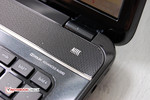
In terms of type and positioning, the speaker exactly corresponds to the one fitted into the sister model. In the HP Pavilion g7-2053sg too an Altec Lansing model with Dolby support is used. And in the current review as well, the speaker convinces with clear trebles and mids, sufficient volume and no interference. A powerful bass is not part of the speaker's range, though.
Power Consumption
As for the HP Pavilion g7-2051sg, for the review model g7-2053sg too, a lithium-ion battery with six cells providing 47 Wh is used by the manufacturer. Compared to the preceding model, power consumption in idle mode is on a very similar level. Consumption between 9.1 and 13.8W is perfectly fine, especially considering the large display. Under load, when processor and graphics are fully stressed, power consumption rises to up to 47.2W. Even with this, the g7-2053sg still stays ten watts under the maximum consumption of its preceding model. This should be reflected in the battery runtime.
| Off / Standby | |
| Idle | |
| Load |
|
Key:
min: | |
Battery Runtime
As suspected, the HP Pavilion g7-2053sg gains advantages in terms of battery life compared to its preceding model. This at least applies to high and middle load. In the Reader's Test with low brightness it performs a bit worse than the g7-2051sg. Just under 20 minutes are not of great importance here, though.
In the everyday use test, enabling WLAN surfing with a realistic brightness of 150 cd/m2, the 17.3" device lasts for very decent 04:32 hours. In this price category, this is definitely nothing to sneeze at, and it allows for longer work times in absence of a power outlet. When playing back DVDs on maximum brightness, the charger does not always have to be at hand: nearly three and a half hours are easily sufficient for most films.
Verdict
The HP Pavilion g7-2053sg's final verdict overlaps with our verdict of the sister model g7-2051sg in many points. The current review model too will find its buyers in the segment of price-conscious consumers looking for a good value desktop replacement. These requirements are fulfilled by the HP Pavilion g7-2053sg also in its less-featured version - at least in terms of performance and features. The latter turn out to be rather generous for such an inexpensive model. Bluetooth would have been a desirable addition, nonetheless. The performance is sufficient for all everyday tasks. Demanding picture and video editing or trying to run the latest games, however, quickly show the model's limitations.
As with the g7-2051sg, the points of criticism of the HP Pavilion g7-2053sg rather refer to the "soft skills" which contribute to the overall impression of a notebook at least as much as the naked specs. On the one hand, one has to mention the mediocre assembly quality which in the review model at least is a bit better than in the recently beforehand tested sister model. On the other hand, the g7-2053sg too annoys with a rather loud but most notably pulsating fan noise. Nonetheless, the thermic design not really make the best impression. Otherwise, the permanent throttling under load cannot be explained. And the display is still a real weak point.
Positively notable is that the battery life profits from the weaker processor. Due to it, the HP Pavilion g7-2053sg almost mutates into a long runner. In any case this means a clear improvement in comparison with the sister model.
In conclusion, we end up with the result that the "smaller" g7-2053sg does its job a bit better than the better equipped brother. In the context of the moderate price of EUR 499, the device has its purpose in any case.
Significantly weaker in performance, but considerably quieter in return is the Packard Bell EasyNote LK11-BZ-080GE. An attractive alternative would be the Samsung Series 3 305E7A-S03DE whose display and volume are better rated. The Acer Aspire 7560G has a better assembly quality.




